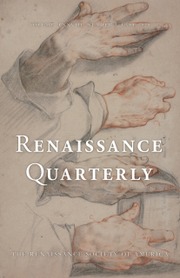The result of innovative collaboration between a physicist and a literary historian, this book proposes network science to explore political communication in Tudor England, using as its database the letters in the State Papers collection. The impressive corpus (132,747 letters involving 20,560 people) makes a computational approach particularly apposite: while each letter may have limited value, tracing exchanges and trajectories offers an invaluable tool for the understanding of power dynamics. Part of a larger project of data- and method-sharing, the book is based on https://tudornetworks.net/. It is extremely clear about both the possibilities and the potential limitations of digital analysis, attempting to realize the distant reading hypothesized by Franco Moretti: a well-chosen approach, given the material at the scholars’ disposal. Besides, the State Papers, marked by different methods of cataloguing and description, are a fascinating topic for archival history. As digital humanities have now entered adulthood and no longer attempt to find incontrovertible truths, the authors warn us against “uncritical positivism” (28). If this book appears, in the end, to offer less than the title promised, this is due to the highly experimental nature of the enterprise.
The book is structured within a theoretical framework: the table of contents proposes approaches and trends rather than times or events, offering insights not only into Tudor history and politics, but also into archival lore and the possibilities offered by a computer-driven approach. Inevitably, the method becomes a central concern: the conclusion to chapter 6 (“This chapter has offered a set of research steps that can be used alone or in combination by researchers,” 203) could be appropriate for the whole work. Tudor Networks offers starting points for further studies; as such, it is generous and courageous, even if occasionally it feels the need to adopt a defensive tone (interestingly, the same quotation about scholars being too prone to rationalize and diminish the finding of digital humanities occurs twice, in the foreword and in chapter 1). Rather than using digital humanities to explain Tudor networks, it uses Tudor networks to explore digital humanities, bringing the discussion on the use of network science significantly forward.
One consequence of this approach is that one misses the sense of a unified argument: rather, what is offered is a series of striking case studies, identifying important if obscure nodes in the network (informants, intelligencers, intermediaries) and highlighting their role in the exchanges. In some of these cases the readers would have been helped by a more systematic contextualization: this kind of enterprise calls for wide-ranging research and, given that the networks under examination often move beyond the British Isles, it is to be regretted that the bibliography appears to be almost exclusively anglophone. On two occasions the scarcity of biographical details is mentioned, accompanied by a comment on the fact that the character under discussion “has neither an entry in the ODNB nor a page on Wikipedia” (65). But in the case of Italians, a useful source might have been the Dizionario Biografico degli Italiani; analogous instruments might have been used in other cases.
Elsewhere, the book offers a more satisfactory development of themes, as in chapter 6, which adopts the strategy of looking for keywords and thus offering an unusual way of examining topics and trends, and above all, in the excellent chapter 5, dedicated to women as letter writers and recipients. Here the data offered by the analysis are significantly helpful in locating the role of both women in power and less important individuals in Tudor society, considering the exceptional circumstances that marked the English sixteenth century, which saw two female monarchs while women in general were forced to maintain a decidedly subordinate position. The authors are faced with some difficult choices, and the decision to propose the exclusion of female monarchs from the percentage computations gives voice to other, hitherto undervalued female figures. A puzzling note appears in the conclusion: “While we cannot do anything about the political marginality of women in the past,…by piecing together the threads of women’s stories we amplify and elevate the position of these women” (144). Surely the point is not to elevate but to establish the position of women.
Fernand Braudel famously invoked so-called social history, a history of groups and groupings, as a core element of historical research. Tudor Networks answers this call by offering a significant step forward in the methodology to be used in this area.


